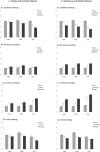Neonatal amygdala or hippocampus lesions influence responsiveness to objects
- PMID: 20583145
- PMCID: PMC4577025
- DOI: 10.1002/dev.20451
Neonatal amygdala or hippocampus lesions influence responsiveness to objects
Abstract
Medial temporal lobe brain structures, such as the amygdala, play an important role in the normal perception and generation of emotional behavior. Little research, however, has assessed the role of such structures across the neurodevelopmental trajectory. We assessed emotional behavioral responses of rhesus macaques that received bilateral ibotenic acid lesions of the amygdala or hippocampus at 2 weeks of age and sham-operated controls. At 9 and 18 months of age, animals interacted with novel objects that varied in visual complexity as a means of varying emotional salience. All animals behaved differently in the presence of visually simple, as compared to complex, objects, suggesting that they were sensitive to variation in emotional salience. Across both experiments, amygdala-lesioned animals appeared to be less behaviorally inhibited insofar as they explored all objects most readily. Interestingly, hippocampus-lesioned animals' propensity for exploration mirrored that of control animals in some contexts but that of amygdala-lesioned animals in other contexts. At 18 months of age, both amygdala-lesioned and hippocampus-lesioned animals were judged to be less fearful than controls during the testing procedure. Implications for understanding the neurobiology of emotional behavior are discussed.
Figures


Similar articles
-
Neonatal amygdala lesions alter responsiveness to objects in juvenile macaques.Neuroscience. 2011 Mar 31;178:123-32. doi: 10.1016/j.neuroscience.2010.12.038. Epub 2011 Jan 6. Neuroscience. 2011. PMID: 21215794 Free PMC article.
-
The development of social behavior following neonatal amygdala lesions in rhesus monkeys.J Cogn Neurosci. 2004 Oct;16(8):1388-411. doi: 10.1162/0898929042304741. J Cogn Neurosci. 2004. PMID: 15509386
-
Sex-dependent role of the amygdala in the development of emotional and neuroendocrine reactivity to threatening stimuli in infant and juvenile rhesus monkeys.Horm Behav. 2013 Apr;63(4):646-58. doi: 10.1016/j.yhbeh.2013.01.010. Epub 2013 Feb 1. Horm Behav. 2013. PMID: 23380162 Free PMC article.
-
Functional organization of the human amygdala in appetitive learning.Acta Neurobiol Exp (Wars). 2017;77(2):118-127. doi: 10.21307/ane-2017-044. Acta Neurobiol Exp (Wars). 2017. PMID: 28691716 Review.
-
Social learning of fear.Nat Neurosci. 2007 Sep;10(9):1095-102. doi: 10.1038/nn1968. Nat Neurosci. 2007. PMID: 17726475 Review.
Cited by
-
Monkey's Social Roles Predict Their Affective Reactivity.Affect Sci. 2021 Jul 27;2(3):230-240. doi: 10.1007/s42761-021-00048-8. eCollection 2021 Sep. Affect Sci. 2021. PMID: 36042947 Free PMC article.
-
The central extended amygdala guides survival-relevant tradeoffs: Implications for understanding common psychiatric disorders.Neurosci Biobehav Rev. 2022 Nov;142:104879. doi: 10.1016/j.neubiorev.2022.104879. Epub 2022 Sep 15. Neurosci Biobehav Rev. 2022. PMID: 36115597 Free PMC article.
-
Increased anxiety-like behaviors, but blunted cortisol stress response after neonatal hippocampal lesions in monkeys.Psychoneuroendocrinology. 2017 Feb;76:57-66. doi: 10.1016/j.psyneuen.2016.11.018. Epub 2016 Nov 18. Psychoneuroendocrinology. 2017. PMID: 27888771 Free PMC article.
-
Neonatal amygdala lesions result in globally blunted affect in adult rhesus macaques.Behav Neurosci. 2011 Dec;125(6):848-58. doi: 10.1037/a0025757. Epub 2011 Oct 10. Behav Neurosci. 2011. PMID: 21988521 Free PMC article.
-
Adult social behavior with familiar partners following neonatal amygdala or hippocampus damage.Behav Neurosci. 2015 Jun;129(3):339-50. doi: 10.1037/bne0000062. Behav Neurosci. 2015. PMID: 26030432 Free PMC article.
References
-
- Aggleton JP, Passingham RE. Syndrome produced by lesions of the amygdala in monkeys (Macaca mulatta). Journal of Comparative and Physiological Psychology. 1981;95:961–977. - PubMed
-
- Bauman MD, Lavenex P, Mason WA, Capitanio JP, Amaral DG. The development of social behavior following neonatal amygdala lesions in rhesus monkeys. Journal of Cognitive Neuroscience. 2004b;16:1388–1411. - PubMed
-
- Bernstein S, Mason WA. The effects of age and stimulus conditions on the emotional responses of rhesus monkeys: Responses to complex stimuli. Journal of Genetic Psychology. 1962;101:279–297. - PubMed
Publication types
MeSH terms
Grants and funding
LinkOut - more resources
Full Text Sources

